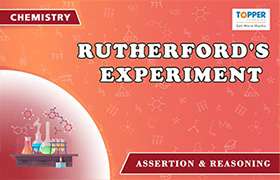CBSE Class 9 Answered
Explain alpaha scaterring experment?Write rutherford's obsevation and drawbacks.
Asked by | 28 Feb, 2008, 09:38: PM
A model of the atom was described by the British physicist Ernest Rutherford in 1911, and is known as the Solar System model.
1. Inherent Instability of the Atom
According to Rutherford's theory, electrons could orbit the nucleus at any distance. When the electrons circle round the nucleus, they are constantly changing their direction. According to classical electrodynamics (which deals with the motion of electrons), such electrons which either constantly change their direction or their velocity or both should continuously emit radiation. While doing so, they should lose energy, and thus spiral into the nucleus. This means every atom is unstable, quite contrary to our observation
Answered by | 20 Dec, 2017, 04:35: PM
Application Videos
Concept Videos
CBSE 9 - Chemistry
Asked by pandeyabhishek1576 | 16 Feb, 2022, 01:24: PM
CBSE 9 - Chemistry
Asked by gspublicschool | 27 Apr, 2020, 11:23: AM
CBSE 9 - Chemistry
Asked by shivajihake1970 | 07 Apr, 2020, 11:31: PM
CBSE 9 - Chemistry
Asked by rk338935 | 11 Jul, 2018, 08:55: PM
CBSE 9 - Chemistry
Asked by Topperlearning User | 16 Mar, 2015, 04:46: PM
CBSE 9 - Chemistry
Asked by Topperlearning User | 30 Mar, 2016, 05:17: PM
CBSE 9 - Chemistry
Asked by Topperlearning User | 13 May, 2014, 11:33: AM
CBSE 9 - Chemistry
Asked by Topperlearning User | 13 May, 2014, 11:33: AM
CBSE 9 - Chemistry
Asked by Topperlearning User | 16 Mar, 2015, 03:03: PM
CBSE 9 - Chemistry
Asked by Topperlearning User | 14 Jul, 2014, 05:13: PM





